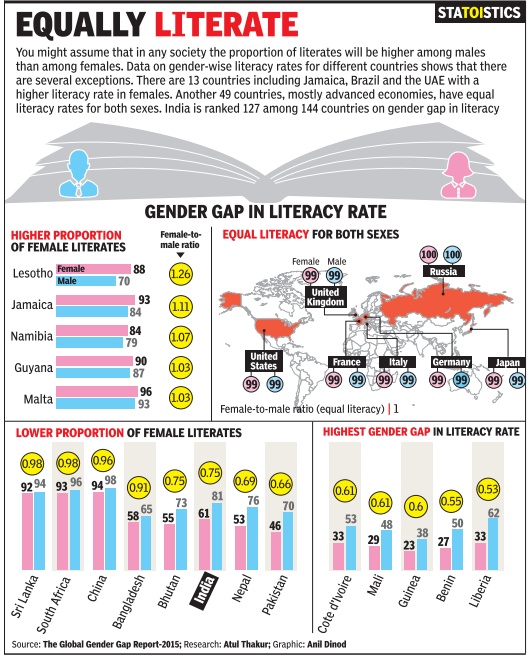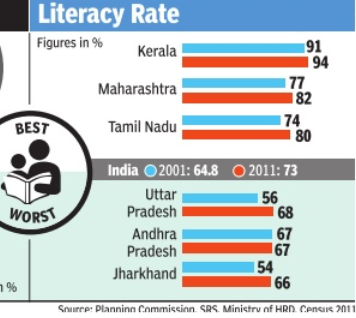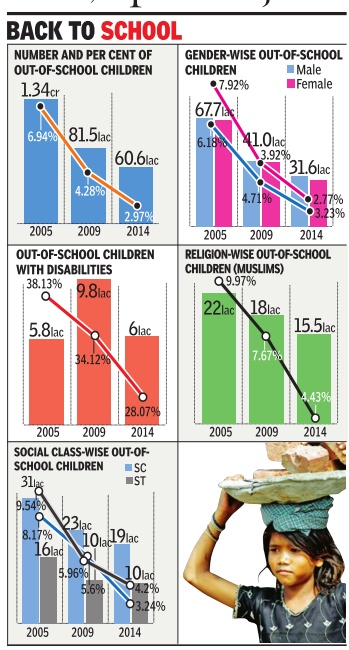Literacy: India
| Line 82: | Line 82: | ||
It noted marriage as second major reason for females (17%) to leave education in urban areas. The survey found that in rural areas, dropouts were mostly in the age-group of 5-15 years for both males and females. In contrast, in urban areas most dropout were in the age-group of 16-24 years. | It noted marriage as second major reason for females (17%) to leave education in urban areas. The survey found that in rural areas, dropouts were mostly in the age-group of 5-15 years for both males and females. In contrast, in urban areas most dropout were in the age-group of 16-24 years. | ||
| + | |||
| + | =India 2nd most `ignorant' among 33 nations= | ||
| + | [http://epaperbeta.timesofindia.com/Article.aspx?eid=31808&articlexml=India-2nd-most-ignorant-nation-Mexico-1st-Study-07122015010039 ''The Times of India''], Dec 07 2015 | ||
| + | |||
| + | ''' India 2nd most `ignorant' nation, Mexico 1st: Study ''' | ||
| + | |||
| + | India has the dubious honour of being the second most ignorant nation in the world after Mexico, according to a survey which posed questions on issues like inequality , non-religious population, female employment and internet access. | ||
| + | The survey conducted by Ipsos MORI, a London-based market research firm, polled 25,000 people from 33 countries and found that while people “overestimate what we worry about“, a lot of major issues are underestimated. | ||
| + | |||
| + | “Mexico and India receive the dubious honour of being the most inaccurate in their perceptions on these issues, while South Koreans are the most accurate, followed by the Irish,“ the survey said. | ||
| + | |||
| + | The rankings of the nations were based on the “index of ignorance“ which was determined by questions about wealth that the top 1% own, obesity , non-religious population, immigration, living with parents, female employment, rural living and internet access. | ||
| + | |||
| + | Most Indians “underestimate“ how much of the country's wealth is concentrated in the hands of the top 1%, the survey said, adding that the top 1% actually own an “incredible“ 70% of all wealth. | ||
| + | |||
| + | The survey also found that most Indians “hugely overestimate“ the proportions of non-religious people in the country to be 33% when the true figure is under 1%. | ||
| + | |||
| + | While Israel significantly underestimates the proportion of female employment (by 29 percentage points), people in countries like India, Mexico, South Africa and Chile all think of more women in work than really are, it said.India fell in the list of nations which overestimate representation by women in politics. | ||
| + | |||
| + | Countries like Columbia, Russia, India and Brazil all think there is better female representation than there really is, the survey said. | ||
| + | |||
| + | However, the Indian population seriously underestimates the rural population of the country and thinks more people have internet access than in reality . | ||
| + | |||
| + | In India, the average guess among online respondents for internet access is 60% -an overestimation of the true picture of 41 percentage points, the survey added. | ||
Revision as of 06:59, 15 December 2015

This is a collection of articles archived for the excellence of their content. Readers will be able to edit existing articles and post new articles directly |
Contents |
Literacy in 2006

India has 37% of world's illiterate adults
IANS| Jan 29, 2014
India has by far the largest population of illiterate adults — 287 million or 37 per cent of the global total, according to the "EFA Global Monitoring Report, 2013-14: Teaching and Learning: Achieving quality for All." Commissioned by Unesco, it said that 10 countries (including India) account for 557 million or 72 per cent of the global population of illiterate adults.
"India's literacy rate rose from 48 per cent in 1991 to 63 per cent in 2006, (the latest year for which data was available), but population growth cancelled the gains. So there was no change in the number of illiterate adults," the report said.
Though India has more than 99 per cent children in schools because of the Right to Education Act, the quality of education being imparted is a big challenge that should be addressed, a top Unesco officer said.
The report also said that a global learning crisis was costing governments $129 billion a year, and that 10 per cent of global spending on primary education was being lost on poor quality education that was failing to ensure that children learn.
"It leaves one in four young people in poor countries unable to read a single sentence, affecting one-third of young women in South and West Asia," it said.
The countries include Bhutan, India, Bangladesh, Sri Lanka and Afghanistan.
Out-of-school children: 2014
RTE effect: 26% drop in number of out-of-school kids since 2009
Akshaya Mukul
The Times of India Oct 14 2014
In a vindication of sorts for the Right to Education (RTE) Act, the latest HRD ministry-mandated survey shows a 26% drop in out-of-school children in the country since 2009.
According to the latest survey conducted by Indian Market Research Bureau for the ministry , out-of-school (OoS) children have declined to 60.6 lakh -2.97% of all children in the 6-14 age group -from 81.5 lakh in 2009. The first survey in 2005 found 1.34 crore out of school.
There were less girls (28.9 lakh) out of school than boys (31.7 lakh). In fact, girls have done better than boys in all three surveys.
A survey of OoS slum children was done for the first time and their number was found to be 4.73 lakh.
The survey found a continuing drop in the number of OoS children among Scheduled Castes and Muslims. Among tribal OoS children, the drop was marginal -from 10.69 lakh in 2009 to 10.07 lakh in 2014. In terms of social classes, the number of SC out-ofschool (OoS) children have come down to 19.66 lakh from 23.08 lakh in 2009 and 31.04 lakh in 2005.
In the latest survey found there were 15.57 lakh Muslim OoS children, down from 18.75 lakh in 2009 and 22.53 lakh in 2005.
While states such as Andhra Pradesh, Assam, Bihar, Jharkhand, Maharashtra, Delhi, Odisha, Rajasthan, Uttar Pradesh and West Bengal witnessed a decline in the OoS children, in 13 states and Union Territories percentage of such children has increased since 2009.
These include Gujarat, Karnataka, Kerala, Chhattisgarh, Punjab, Madhya Pradesh, Tamil Nadu and Uttarakhand.
What dampens the good work of RTE is that the decline in OoS disabled children has followed a different trajectory.
In 2005, 5.82 lakh disabled children were out of school which went up to 9.88 lakh in 2009 and in the latest round has come down to 6 lakh. Sources said it could be due to inclusion of more kinds of mental and physical disabilities in the list so that RTE becomes more inclusive. But there is a general acknowledgement that a lot needs to be done on this front.
January-July 2014: Dropout level
The Times of India, Jul 06 2015

Mahendra Singh
`11% of rural, 6% of urban people under 30 never went to schools'
Around 11% of those between 5-29 years of age in rural areas and 6% in urban areas never went to any educational institution, reveals an NSSO survey conducted between January and July , 2014. The students of the same age group who dropped out were around 33% in rural areas and 38% in urban areas. The survey has highlighted that the proportion of dropouts and `never enrolled' students depended on the living standards of households.The dropout rate was low in case of families with higher usually monthly per capita consumer expenditure (UMPCE). It was found that the proportion of the `never enrolled' category fell steeply from nearly 16% in the poorest households to only 6% among the richest in rural areas. In urban India, too, the percentage dropped from 12% to 1% from the bottom to the top class of households.
The survey found that the proportion of `never enrolled' persons in early 2014 had reduced by around 30% as compared to 2007-08.
However, it noted that the overall picture for proportion of dropouts, both in rural and urban areas, had not changed significantly over time as well as over UMPCE classes.
The survey revealed that the major reason for non-enrolment in rural areas was `not interested in education' (33% male and 27% female) while in urban areas, nearly 33% males and 30% females in the age group 5-29 years never enrolled because of `financial constraints'. The most common reason for dropping out for males was engagement in economic activities (30% in rural areas and 34% in urban areas), whereas for the females, the dominant reason was engagement in domestic activities (33% in rural areas and 23% in urban areas).
It noted marriage as second major reason for females (17%) to leave education in urban areas. The survey found that in rural areas, dropouts were mostly in the age-group of 5-15 years for both males and females. In contrast, in urban areas most dropout were in the age-group of 16-24 years.
India 2nd most `ignorant' among 33 nations
The Times of India, Dec 07 2015
India 2nd most `ignorant' nation, Mexico 1st: Study
India has the dubious honour of being the second most ignorant nation in the world after Mexico, according to a survey which posed questions on issues like inequality , non-religious population, female employment and internet access. The survey conducted by Ipsos MORI, a London-based market research firm, polled 25,000 people from 33 countries and found that while people “overestimate what we worry about“, a lot of major issues are underestimated.
“Mexico and India receive the dubious honour of being the most inaccurate in their perceptions on these issues, while South Koreans are the most accurate, followed by the Irish,“ the survey said.
The rankings of the nations were based on the “index of ignorance“ which was determined by questions about wealth that the top 1% own, obesity , non-religious population, immigration, living with parents, female employment, rural living and internet access.
Most Indians “underestimate“ how much of the country's wealth is concentrated in the hands of the top 1%, the survey said, adding that the top 1% actually own an “incredible“ 70% of all wealth.
The survey also found that most Indians “hugely overestimate“ the proportions of non-religious people in the country to be 33% when the true figure is under 1%.
While Israel significantly underestimates the proportion of female employment (by 29 percentage points), people in countries like India, Mexico, South Africa and Chile all think of more women in work than really are, it said.India fell in the list of nations which overestimate representation by women in politics.
Countries like Columbia, Russia, India and Brazil all think there is better female representation than there really is, the survey said.
However, the Indian population seriously underestimates the rural population of the country and thinks more people have internet access than in reality .
In India, the average guess among online respondents for internet access is 60% -an overestimation of the true picture of 41 percentage points, the survey added.
